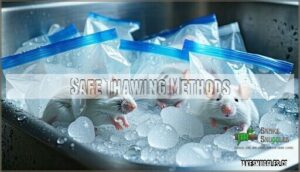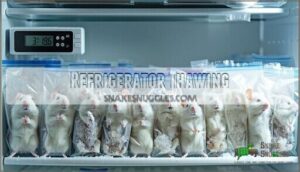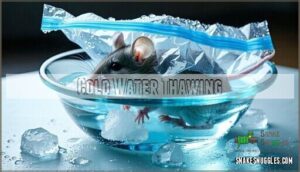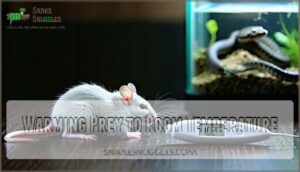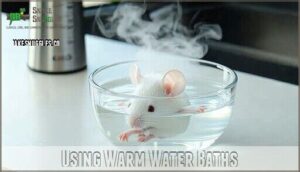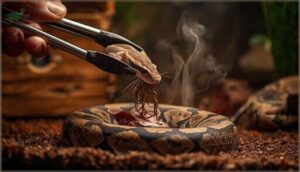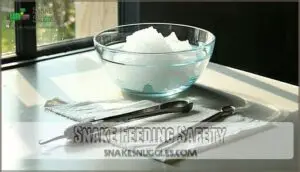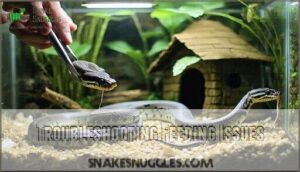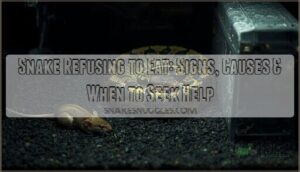This site is supported by our readers. We may earn a commission, at no cost to you, if you purchase through links.

Never use microwaves, as they create dangerous hot spots that can burn your snake’s mouth. Once thawed, warm the prey in a water bath until it reaches room temperature, then use feeding tongs to offer it safely.
This method reduces injury risk while ensuring your snake gets proper nutrition. Mastering the right techniques can turn even the pickiest eater into an enthusiastic diner.
Table Of Contents
- Key Takeaways
- Thawing Frozen Prey
- Preparing Frozen Rodents
- Feeding Techniques
- Snake Feeding Safety
- Troubleshooting Feeding Issues
- Frequently Asked Questions (FAQs)
- What to feed a frozen snake?
- Can snakes eat unfrozen rodents?
- How do you feed a snake?
- Can a corn snake eat frozen food?
- Can a snake eat a frozen feeder?
- How do you feed a corn snake?
- How to feed a snake frozen?
- How long should I thaw my snakes food?
- How often should I feed my snake?
- What size prey is appropriate for snakes?
- Conclusion
Key Takeaways
- You’ll need to thaw frozen prey safely using a refrigerator overnight (8-12 hours) or cold water method (30-60 minutes) – never use microwaves as they create dangerous hot spots that can burn your snake’s mouth.
- You must warm thawed prey to 100-105°F using warm water baths before feeding to trigger your snake’s natural feeding response and ensure proper digestion.
- You should use feeding tongs to offer prey safely, maintaining 12-15 inches distance and gently wiggling the rodent to mimic natural movement that encourages strikes.
- You can’t refreeze thawed prey due to bacterial contamination risks – always practice proper hygiene by washing hands, using sealed bags, and disposing of uneaten food promptly.
Thawing Frozen Prey
You’ll need to thaw frozen prey properly to keep your snake healthy and prevent bacterial contamination.
The right thawing method guarantees your snake gets safe, warm food that triggers its natural feeding response.
Safe Thawing Methods
Safe thawing frozen prey prevents bacterial contamination and maintains temperature consistency for your snake’s health.
Gradual thawing using refrigerator thawing or cold water speed thawing maintains prey quality while following proper thawing timeframes.
These safe alternatives to microwave heating require temperature verification before feeding.
Always use contamination prevention methods like sealed bags during the thawing process to guarantee temperature consistency for your snake’s health.
Refrigerator Thawing
Refrigerator thawing remains the gold standard for safe snake feeding because it delivers consistent, even thawing while minimizing bacterial risks.
This method requires patience but guarantees your snake’s health and safety.
- Place frozen prey in sealed plastic bags to prevent contamination and maintain freshness during the thawing process
- Allow 8-12 hours for overnight thawing depending on prey size, with larger rodents requiring extended thawing duration
- Maintain refrigerator temperatures between 35-40°F to create safe temperatures that prevent bacterial growth throughout the process
- Check prey reaches room temperature before feeding by gently touching the rodent’s body to confirm complete thawing
- Never refreeze previously thawed prey as this creates serious bacterial risks that could harm your snake’s digestive system
Cold Water Thawing
When time’s ticking, cold water thawing offers a faster solution than refrigerator thawing.
Place your sealed bag containing frozen prey into cold water for 30-60 minutes, depending on prey size.
Change the water every 10-15 minutes to maintain consistent water temperature and guarantee even thawing.
This thawing technique works well for most frozen snakes’ feeding schedules, following safe thawing practices to prevent bacterial growth, as outlined in the link: safe thawing practices, which is a crucial step for preventing bacterial growth.
Avoiding Microwave Thawing
Microwaves create uneven heating that leaves cold spots where bacterial risks multiply.
This cooking method destroys essential nutrients your snake needs. Uneven heating also creates dangerously hot areas that can burn your snake’s mouth.
Stick to proper frozen food preparation using warm water thawing techniques instead. Your snake deserves safe, evenly warmed meals that preserve nutritional value.
Preparing Frozen Rodents
Once you’ve properly thawed your frozen rodent, you’ll need to warm it to the right temperature to trigger your snake’s feeding response.
The prey should reach 100-105°F to mimic a live animal’s body temperature and encourage natural hunting behavior.
Warming Prey to Room Temperature
After thawing, you must warm your frozen prey to room temperature before feeding.
Cold food can shock your snake’s digestive system and reduce feeding response.
Here’s how to achieve ideal temperature:
- Temperature Monitoring – Use your hands or thermometer to verify prey reaches 100-105°F
- Warming Methods – Employ warm water baths, heat lamps, or gradual room temperature warming
- Palatability Factors – Proper warming enhances scent and triggers natural hunting instincts
Using Warm Water Baths
Warm water baths offer precise control over thawing techniques and warming temperatures. Fill a container with water at the ideal temperature of 95-110°F. Place your bagged prey in the bath for proper duration based on size.
| Method | Duration |
|---|---|
| Small prey (mice) | 15-20 minutes |
| Medium prey (rats) | 25-30 minutes |
| Large prey | 30-45 minutes |
Always use bagged vs unbagged methods to prevent nutrient loss. It’s important to use airtight bags to prevent rodent freezer burn. Change water if it cools during the process. This snake feeding temperature mimics warmth naturally, triggering feeding responses effectively.
Heating Prey With Heat Lamps
Heat lamps offer another warming method, though they require careful temperature control to prevent overheating risks.
Position your lamp at a safe distance from the prey to avoid creating dangerous hot spots. Different bulb types provide varying heat levels, so choose reptile-specific options over household bulbs.
It’s important to select the right bulb, considering reptile heat needs for ideal warmth. Monitor the prey’s surface temperature closely, aiming for that perfect basking spot warmth of 95-100°F.
This method works well for smaller rodents but needs constant supervision.
Adding Scent Appeal With Broth
Picky eaters can benefit from scent stimulation using warm chicken or rodent broth.
Dip the thawed prey’s head briefly in the broth to enhance scent appeal.
This scenting technique triggers feeding responses in reluctant snakes.
Prepare fresh broth for each feeding session to maintain safety and effectiveness for long-term scent training success.
Feeding Techniques
Once you’ve properly thawed and warmed your frozen prey, you’ll need to choose the right feeding technique for your snake.
The method you select can make the difference between a successful meal and a frustrated feeding session, so let’s explore the most effective approaches that work for different snake species and situations.
Using Tongs for Feeding
Grip your feeding tongs by the rodent’s scruff, maintaining a 12-15 inch distance for safety. Wiggle the prey gently to mimic natural movement and encourage your snake’s strike response.
This technique works especially well for reluctant feeders who need extra motivation. Using specialized feeding equipment can greatly improve safety.
Never jerk the prey away when your snake strikes—let them secure their meal naturally.
Feeding in Separate Enclosures
Many snake keepers prefer using a separate container feeding approach for stress reduction and safer snake feeding.
You’ll move your snake to a dedicated feeding enclosure like a Rubbermaid tub before offering prey. This method prevents cage association where your snake expects food every time you open its main habitat.
While handling concerns increase with this technique, observation ease improves since you can monitor feeding behavior closely.
Consider using a dedicated feeding container to maintain hygiene. Choose an appropriate enclosure size that allows comfortable movement without being too spacious.
Dropping Food Into The Cage
Dropping food into your snake’s cage offers the most straightforward snake feeding approach.
This simple method requires minimal equipment and limited interaction with your pet. You’ll place the thawed frozen prey on a clean plate inside the enclosure, ensuring easy accessibility.
While convenient, some keepers worry about cleanliness concerns since the snake feeding guide technique doesn’t prevent substrate contact. A reptile feeding dish can help maintain a cleaner feeding environment.
Most snakes accept this direct approach regardless of snake preference.
Mimicking Natural Prey Movement
While static placement works well, your snake’s natural hunting instincts respond better to wiggling prey.
Use feeding tongs to grip the rodent and create gentle movements that entice strike behavior. This movement mimicry awakens their hunting behavior, making even reluctant eaters more likely to feed.
- Tongs technique: Grip the prey by its neck and wiggle it slowly to stimulate feeding responses
- Thawing techniques: Properly warmed prey moves more naturally when manipulated with tongs
- Gentle movements: Avoid jerky motions that might stress your snake or damage the rodent
- Rodent movement: Mirror natural prey behavior by alternating between stillness and small movements
Snake Feeding Safety
Feeding frozen prey safely protects both you and your snake from harmful bacteria and health risks.
You’ll need to follow proper hygiene practices and monitor your snake’s condition to guarantee successful, safe feeding sessions.
Preventing Bacterial Contamination
Proper hygiene prevents bacterial contamination during snake feeding.
Always wash your hands for 20 seconds after handling frozen prey or equipment.
Use dedicated tools and sealed bags for thawing – never kitchen surfaces or utensils.
Store frozen snake food separately from human food to maintain safe snake handling practices.
| Safe Handling Practice | Why It Matters |
|---|---|
| Wash hands 20+ seconds | Removes Salmonella and bacteria |
| Use sealed bags for thawing | Prevents cross-contamination |
| Dedicated feeding tools only | Keeps human food areas clean |
| Separate storage spaces | Reduces kitchen exclusion risks |
Avoiding Refreezing Thawed Prey
Once you’ve thawed frozen prey, never refreeze it. This creates serious health risks for your snake through bacterial growth and food spoilage.
**Never refreeze thawed prey—bacterial growth puts your snake’s health at serious risk.
Why refreezing dangers matter:
- Bacterial contamination multiplies rapidly during thaw-refreeze cycles
- Nutrient loss occurs each time you refreeze prey
- Food spoilage accelerates, creating toxins harmful to snakes
- Health risks include digestive issues and potential illness
Always practice safe disposal of unused thawed prey to protect your snake’s health; remember to follow USDA thawing guidelines for maximum safety.
Maintaining Proper Hygiene
Clean hands thoroughly before and after handling frozen prey. Sanitize tongs and feeding tools with disinfectant between uses.
Wipe down enclosure surfaces regularly to prevent bacteria buildup. Store rodents away from kitchen areas to avoid cross-contamination.
Dispose of uneaten prey promptly. These snake feeding hygiene practices protect both you and your pet from harmful germs, ensuring a clean environment for your pet.
Monitoring Snake Health
Watching your snake’s health closely prevents serious feeding problems from developing.
Regular observation helps you spot trouble early and take action before minor issues become major concerns.
- Weight changes – Monitor body condition weekly; sudden weight loss or gain signals feeding issues
- Regurgitation signs – Look for undigested prey, unusual mouth movements, or stomach contractions after meals
- Lethargy causes – Note reduced activity, poor positioning, or lack of interest in surroundings
- Respiratory issues – Watch for mouth breathing, wheezing sounds, or visible stress during feeding times
Troubleshooting Feeding Issues
Even the most experienced snake keepers encounter feeding challenges from time to time.
When your snake refuses food or shows unusual feeding behavior, you’ll need specific strategies to identify and solve the problem quickly.
Dealing With Reluctant Eaters
When your snake turns its nose up at dinner, don’t panic.
Stubborn eaters often respond to scenting techniques like dipping prey in sodium-free chicken broth.
For particularly picky eaters, try braining prey by exposing brain matter to trigger feeding response.
The cupping method works well – place snake and prey in a small, warm container for privacy.
Adjusting schedule to nighttime feeding helps nocturnal species.
If these strategies fail, consider that the snake might be experiencing temporary appetite loss due to shedding.
Adjusting Feeding Techniques
When your snake won’t eat, experimenting with different approaches can make all the difference.
Try adjusting Prey Size to smaller options or switching Feeding Frequency to match your snake’s natural rhythm.
Nocturnal Feeding works wonders for many species—offer food at dusk when hunting instincts kick in.
Scenting Prey with chicken broth adds irresistible appeal, while Live Feeding might jumpstart stubborn eaters before switching back to frozen options.
Consulting a Veterinarian
When refusal persists beyond a few weeks, weight loss becomes noticeable, or regurgitation issues occur repeatedly, it’s time to seek specialist help.
Lethargy signs combined with feeding problems indicate potential health risks that require reptile vet expertise.
A specialist needed consultation guarantees proper snake health assessment and targeted snake feeding veterinary advice for your snake care routine.
Addressing Common Feeding Problems
When your snake won’t eat, several common feeding problems typically emerge.
Understanding these issues helps you troubleshoot effectively and maintain your pet’s health through proper care adjustments.
- Regurgitation Causes include oversized prey, improper food size selection, or handling too soon after meals
- Environmental Stressors like incorrect temperatures, humidity levels, or shedding issues disrupt normal feeding patterns
- Picky Eaters and stubborn eaters often require scenting techniques, feeding frequency adjustments, or addressing snake feeding refusal through patience
Frequently Asked Questions (FAQs)
What to feed a frozen snake?
Like warming a cold heart back to life, you’ll need to properly thaw your frozen snake’s meal.
Always thaw frozen rodents completely in sealed bags using refrigerator overnight or warm water baths.
Never feed frozen prey directly, and ensure the thawing process is done correctly to avoid any issues.
Can snakes eat unfrozen rodents?
Yes, snakes can eat fresh rodents that’ve never been frozen. However, you’ll need to make certain they’re properly sourced, handled safely, and fed immediately to prevent bacterial contamination risks.
How do you feed a snake?
About 95% of captive snakes eat pre-killed frozen prey, making proper preparation essential.
You’ll thaw frozen rodents overnight in sealed bags, warm them to body temperature, then offer using feeding tongs while wiggling to trigger strikes.
Can a corn snake eat frozen food?
Corn snakes can definitely eat frozen rodents.
You’ll need to thaw the frozen prey completely in the refrigerator overnight, then warm it to room temperature or slightly warmer before offering it to your snake.
Can a snake eat a frozen feeder?
No, you shouldn’t feed snakes frozen prey directly from the freezer.
You’ll need to thaw the rodent completely first, then warm it to room temperature or slightly warmer before offering it to your snake for safe digestion.
How do you feed a corn snake?
Looking to feed your corn snake safely?
Thaw frozen rodents overnight in the refrigerator, then warm them in a sealed bag using warm water until they reach room temperature.
Use tongs to offer the prey.
How to feed a snake frozen?
Thaw frozen prey overnight in your refrigerator inside a sealed bag.
Then warm it to body temperature using warm water.
Use tongs to offer the rodent, wiggling gently to trigger your snake’s natural feeding response.
How long should I thaw my snakes food?
Notably, timing matters more than you’d think when thawing your snake’s meal.
You’ll need overnight refrigerator thawing for complete results, or 30-60 minutes in cold water for faster thawing.
Ensuring it reaches room temperature before feeding.
How often should I feed my snake?
Adult snakes typically need feeding every 1-2 weeks, while juveniles require food every 5-7 days. You’ll adjust this schedule based on your snake’s age, size, and species requirements.
What size prey is appropriate for snakes?
Like Goldilocks seeking the perfect porridge, you’ll want prey that’s "just right" – not too big, not too small.
Choose rodents that match your snake’s thickest body section, ensuring they won’t cause regurgitation or feeding difficulties for ideal health.
Conclusion
Practice makes perfect when mastering the best snake feeding guide frozen techniques you’ve learned.
You’ll transform feeding time from stressful to straightforward by following proper thawing methods, maintaining hygiene standards, and using safe feeding practices.
Remember that patience pays off with picky eaters—sometimes adjusting your approach makes all the difference.
Your snake’s health depends on consistent, safe feeding habits that prioritize both nutrition and safety.
- https://www.laynelabs.com/product/frozen-mice/
- https://bigcheeserodents.com
- https://www.reddit.com/r/reptiles/comments/1fiux4y/whats_the_quickest_way_to_defrost_frozen_rodents/
- https://vcahospitals.com/know-your-pet/snakes-feeding
- https://www.rodentpro.com/informationcenter/resources/feeding-frozen-thawed-prey-items-to-snakes-in-captivity

